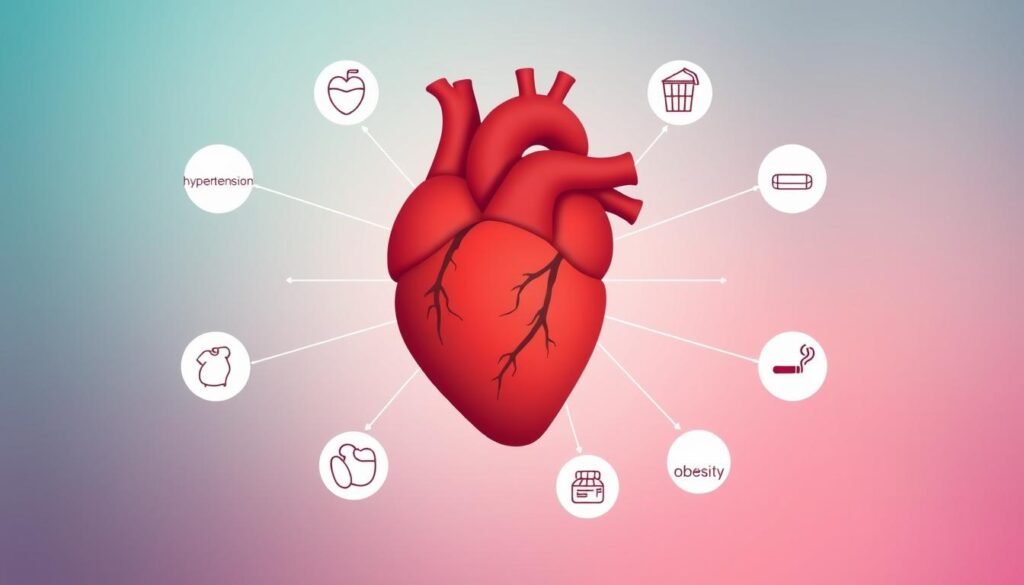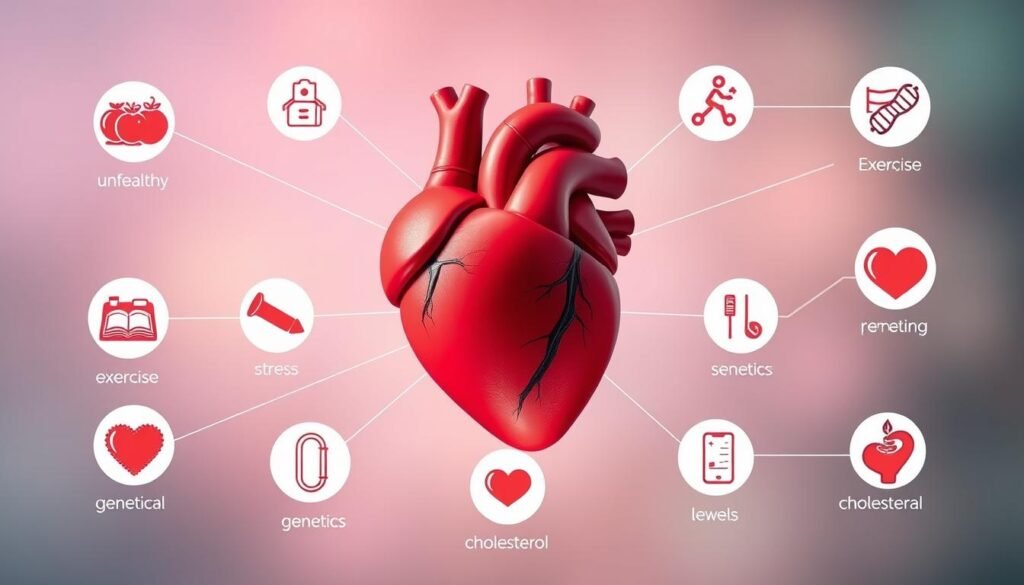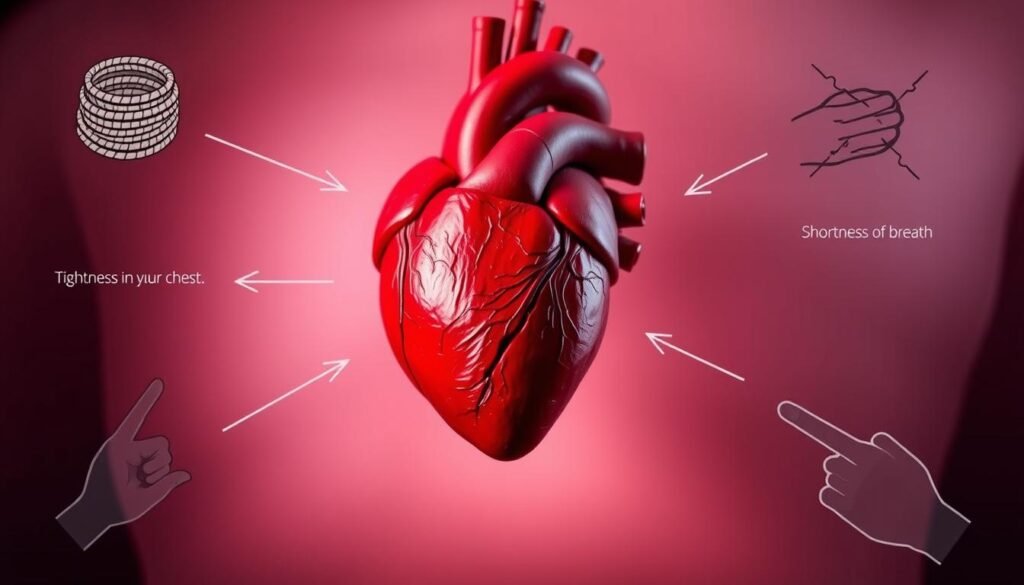Chest pain often tells us our heart isn’t getting enough blood. This major red flag could mean a heart attack is near. But it’s easy for people to miss or misunderstand these warning signs. Knowing what to watch for can help us act before it’s too late. Heart disease leads to many deaths each year. Recognizing signs early can keep your heart healthy.
Learning about the signs of heart disease helps us catch it early. Finding it early can improve chances of survival and health. Look out for symptoms like shortness of breath and extreme tiredness. This can help you take control of your health early on. Our guide will show you important warning signs. So, you won’t have to face heart disease’s dangers by yourself.
Key Takeaways
- Chest pain is the most common warning signal for heart problems.
- Recognizing symptoms like shortness of breath can lead to earlier intervention.
- Extreme fatigue should not be ignored, as it may indicate heart trouble.
- Awareness of symptoms can significantly improve cardiovascular health outcomes.
- Timely medical attention for warning signals can be lifesaving.
The Importance of Recognizing Heart Disease Symptoms
It’s key to know the signs of heart disease early. Doing so can save lives by catching the disease before it gets worse. When people recognize these symptoms, they can get help faster. This reduces the chance of heart attacks and strokes.
As people get older, their hearts don’t handle stress as well. Older people might find their hearts don’t speed up or slow down as quickly during exercise. They also might notice more irregular heartbeats. It’s important to watch for these signs as you age.
Your heart can change shape and get stiffer as you age. These changes might lead to heart problems like atrial fibrillation. They can also cause fluid build-up and more health issues. Keeping an eye on your blood pressure and cholesterol is key to avoiding serious problems.
Men and women might see different heart disease symptoms. Symptoms like chest pain, feeling out of breath, and being extra tired need quick action. Tests like ECGs and echocardiograms help doctors figure out what’s going on with your heart.
Making smart choices early can cut down on heart problems. Early intervention is crucial. Being active and eating right can keep your heart strong. This helps avoid the dangers of heart disease.
Common Symptoms of Heart Disease
It’s crucial to know the common signs of heart disease for early treatment. Symptoms can vary a lot from person to person. Below are some widespread symptoms to watch out for.
Chest Pain and Angina
Chest pain is a well-known symptom of heart issues. It might feel like pressure or a tight squeeze in your chest. Angina happens when your heart doesn’t get enough blood, pointing to serious heart problems. If you feel any chest pain, get medical help right away. It’s an important warning sign of heart disease.
Shortness of Breath
Feeling short of breath during daily activities or even while resting can happen. This may indicate heart failure, where fluid backs up in the lungs. This makes normal breathing tough. Be alert to any unexpected breathing issues, particularly with other symptoms.
Fatigue and Weakness
Feeling unusually tired can signal heart problems, especially in women. This tiredness could mean the heart isn’t pumping well. If rest doesn’t help the fatigue, seeing a doctor is important. You can learn more about fatigue and heart conditions here.
Heart disease signs can show up in different ways. Recognizing these signs early can help with quicker treatment and better health. Regular health check-ups and listening to your body are key for good heart health.
Understanding Angina: A Key Indicator
Angina is a crucial warning sign of heart disease, especially ischemic heart disease. It occurs when the heart muscle gets less blood, usually due to narrowed arteries. There are various forms of angina with different levels of severity.
Stable angina is most common and usually lasts up to five minutes. It’s often caused by physical effort or stress. On the other hand, unstable angina is serious and can last over 20 minutes, indicating a higher heart attack risk. Variant angina, also known as Prinzmetal angina, is caused by artery spasms and often happens at rest.
Symptoms of angina can be different, especially in women. Women might feel discomfort in the neck, jaw, back, or stomach instead of just the chest. Risk factors include getting older, family history of heart disease, smoking, diabetes, and high blood pressure.
Heart attack warning signs can be similar to angina symptoms. These include lasting chest pain, pain spreading to arms, back, or jaw, and other symptoms like fainting and nausea. If you see these signs, get medical help right away.
To prevent angina, live a healthy lifestyle. Avoid smoking and too much alcohol. Eat healthily, exercise regularly, and manage stress. Watching your symptoms and following your treatment plan can help control angina. This will also lower your heart disease risk.
Identifying Serious Underlying Conditions like Heart Disease
Knowing the risks of heart disease is key to keeping a healthy heart. Many factors, like high blood pressure, diabetes, and bad cholesterol, play a role. It’s important to look at these factors closely to keep them in check.
High blood pressure is a big warning sign for heart problems. People with chronic kidney disease also have a higher chance of getting heart disease. Being overweight increases your risk for diabetes and high blood pressure. This, in turn, raises your chances of heart disease. A body mass index (BMI) above 25 means you’re at higher risk.
Making smart lifestyle choices helps with heart health. Exercise regularly and eat foods low in saturated fats and sugars. It’s also key to drink alcohol in moderation. Too much can lead to weight gain and more heart risk. Stick to no more than 14 units of alcohol each week.
Getting regular checks is another way to stay ahead. Doctors can watch for issues that lead to heart disease early on. This helps in managing these issues better for overall health. To learn more about preventing heart disease, see the CDC guidelines on heart disease risk.

Additional Warning Signs of Heart Issues
Knowing more signs of heart issues is key for early action and preventing big problems. Heart concerns can show up in many ways, like palpitations and swelling. It’s important for people to notice these signs and get medical help quickly.
Palpitations and Irregular Heartbeats
Palpitations feel like your heart is racing or fluttering. These can mean you have an arrhythmia, which is serious for heart health. It’s crucial to keep track of how often and how long this happens. See a doctor if it keeps happening.
Swelling and Edema
Swelling in your legs or belly can mean edema, which is fluid buildup. This happens when your heart can’t pump blood well, showing your heart might be getting weaker. Noticing swelling is important to deal with heart issues early.
Other Physical Manifestations
Skin color changes, like looking pale or blue, show poor blood flow. These signs can be easy to miss but are key warnings of heart problems. Knowing and spotting these changes helps understand heart health, leading to needed doctor visits.
Factors Influencing Heart Disease Risk
Understanding how different factors affect heart disease risk is key. Lifestyle choices and genetics both have a big role in one’s heart health. By changing certain habits, you can improve your risk analysis for heart disease.
Lifestyle Choices and Habits
Your daily habits have a big impact on heart disease risk. Poor diet, not moving enough, smoking, and too much alcohol can raise your risk. Making better lifestyle choices helps a lot. This includes exercising regularly, eating more vegetables, and avoiding tobacco.
Changing these habits could prevent many heart diseases. For tips on how to manage these factors, check out this resource.
Genetic Predisposition
Some risk factors, like genetics, can’t be changed. Having family with heart disease makes your own risk higher. This shows why regular check-ups and proactive healthcare are necessary.
Knowing your family health history can help you make better choices. And it’s vital for keeping an eye on your heart health.

The Role of Medical Screening in Early Detection
Regular medical check-ups are key to catching heart disease early. They help doctors find risk factors and conditions before you get really sick. Doctors look at your blood pressure, do cholesterol tests, and use advanced tools like imaging.
Many people don’t know they have heart issues. A study found that 27.0% had unseen health problems and were not getting treated. This shows how crucial screenings are for discovering hidden risks.
Heart disease is a big reason people die worldwide. It caused 85% of the 17.9 million deaths in 2016. Finding heart problems early can cut down this number. It gives people a chance to get treatment sooner.
Screening helps people who might be at risk. One program had a low turnout of 9.7%. But, it gave valuable health info to those who joined. Regular tests can find issues like high blood pressure early. This can make people healthier in the long run.
The American Heart Association says you should start getting heart tests at 20. This helps you take care of your health early on. If you skip these tests, illnesses can get worse unnoticed. This makes treatment later much harder.
Symptom Evaluation: When to Seek Help
Knowing when to seek help is key for heart health. Looking for symptoms is a big part of checking for heart problems. Being quick to spot urgent signs can lead to fast help. This part talks about important signs that mean you need help right away. It also shares steps to take next.
Recognizing Urgent Warning Signs
It’s crucial to know certain signs that show serious heart issues. These signs include:
- Severe chest pain
- Sudden shortness of breath
- Irregular heartbeats
- Unexplained fatigue or weakness
- Persistent dizziness or light-headedness
Don’t wait to get help if you see these signs. Checking your heart early can stop problems and help manage health issues well.
Appropriate Next Steps for Individuals
If you see urgent signs, call for help or go to a hospital. Doctors will do tests like:
| Test | Description |
|---|---|
| Blood Tests | Measure heart muscle damage indicators. |
| Echocardiogram | Uses ultrasound to see heart structure and function. |
| Nuclear Cardiac Stress Test | Assess blood flow and heart efficiency. |
| Coronary Angiogram | Finds blockages in coronary arteries. |
| Magnetic Resonance Imaging (MRI) | Gives detailed images for diagnosis. |
| Coronary Computed Tomography Angiogram (CCTA) | A non-invasive scan for artery disease. |
Even if symptoms don’t seem bad, still see a doctor for ongoing issues. A full check-up helps make a care plan just for you.

Cardiovascular Health and Disease Prevention
To keep your heart healthy, you must take steps to avoid disease. Adults should get at least 150 minutes of moderate exercise every week. This greatly lowers the risk of getting heart disease. Eating well is also key. Following the DASH or Mediterranean diet helps manage blood pressure and cholesterol. This can also cut down on the risk of diabetes.
It’s important to keep a healthy weight to protect your heart. If your BMI is 25 or more, you’re more at risk for high cholesterol and blood pressure. This can lead to heart disease and stroke. Getting at least 7 hours of sleep every night is vital. It helps in reducing the chances of obesity and related health problems. Managing stress properly is important, too. Long-term stress can push your blood pressure up.
Getting checked for things like high blood pressure and cholesterol is key. If you have a family history of these issues, see your doctor every 4 to 6 years. These check-ups help catch and treat problems early. This proactive approach keeps small issues from getting bigger.
Good dental care is also part of preventing heart disease. Gum disease can be linked to heart problems. So, it’s good to go for regular dental visits and stay up-to-date with vaccinations. Using these steps helps you improve heart health and lower disease risk.
Conclusion
Knowing how to spot heart disease signs is key to better health. Heart disease is a big issue. It’s very important to know about symptoms and risks. About one in three U.S. adults has high blood pressure. This shows why it’s vital to understand this condition.
Regular check-ups and learning more can really help prevent heart disease. If we manage high blood pressure well, we can greatly reduce heart failure risk by 64%. It’s also important to live healthier. Many heart problems can be avoided this way.
To sum it up, it’s crucial for people to learn about heart disease signs. Support from healthcare systems helps fight this major health problem. When we all know more and get better at taking care of our health, we can improve heart health for everyone.